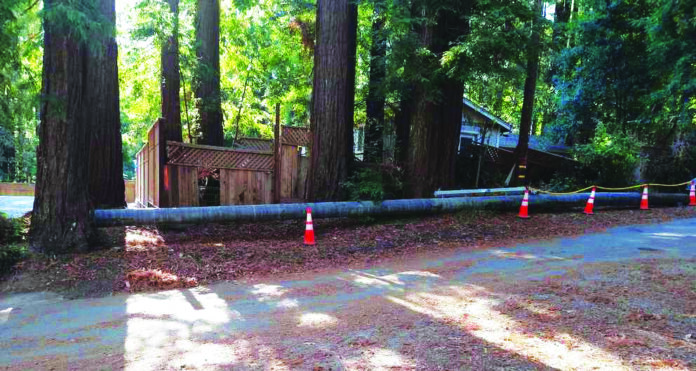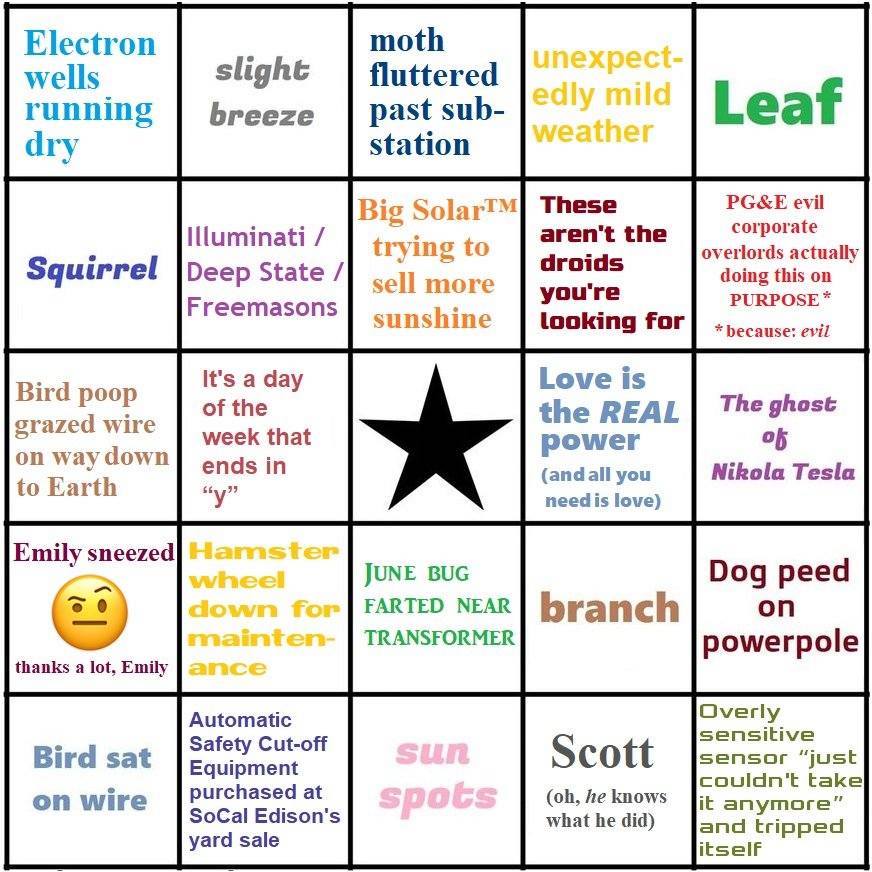
For people living in Boulder Creek, Brookdale, Ben Lomond and Felton, power outages have become a prominent aspect of daily life rather than an occasional annoyance.
During the last week of July, San Lorenzo Valley communities experienced a sustained loss of power every day for five days, sometimes multiple times per day. It would be one thing if the power flickered and came back on, but these outages lasted for hours and included the loss of phone and internet service to boot.
The inanity of it all has led to frustration, isolation and a growing shared affirmation by residents to no longer tolerate the constant, unplanned interruptions. From rotten food to lost wages to a loss of safety, SLV residents are up in arms over the impact these outages are having on their everyday lives, and they are raising their collective voices against the entity responsible for their hardships: Pacific Gas & Electric (PG&E).
Leading the charge with a serving of humor is Ben Lomond resident Daniel DeLong, who has lived in Santa Cruz County since 1984, and in the San Lorenzo Valley for 30 years. DeLong is the creator of Power Outage Bingo, wherein local residents can play along in guessing the cause each time the power goes out.
DeLong is no stranger to the challenges of mountain living. When the CZU Lightning Complex descended into SLV neighborhoods in August of 2020, he and his family, whose home is perched along Alba Road, were evacuated from the area. After 40 days of living in Aptos, DeLong returned to his home to find it still standing, while five of his neighbors’ homes were decimated.
Since the CZU fire, DeLong has been disillusioned by the response by PG&E when it comes to providing its customers with the product everyone needs: power.
“We live in a rural area of the county, and storms are going to cause power outages. I accept that as part of mountain living. But the power outages that are caused because the utility didn’t calibrate their emergency shutoff equipment, or planned outages that wreak havoc on communities are unacceptable,” said DeLong. “Ultimately, it all comes down to money. PG&E needs to take care of its shareholders and pay outrageous sums to their executives, and their customers suffer in the long run.”

To be fair, DeLong said he supports the boots-on-the-ground cadre of linemen and specialists who work each day to keep the lights on. His disgust, he explained, lies with those at the top of the PG&E food chain who are making an exorbitant amount of money while customers continue to struggle through power outages.
In 2021, the Securities and Exchange Commission reported that newly-minted PG&E CEO Patricia Poppe raked in $51.2 million in total direct compensation. In addition, John Simon, the utility’s chief ethics and compliance officer, brought in over $3.1 million, Chief Customer Officer Marlene Santos saw her pocketbook enriched by nearly $7.5 million, and Adam Wright, the chief operating officer, saw his bank account grow by nearly $6.5 million in 2021.
Sean Winn, who lives in Lompico, has felt his frustration mount since last year. In October of 2020, Winn took a picture of a brand new power pole placed on his road by PG&E. While that sounds promising, the pole was never installed, but instead has been laying alongside the road, gathering spiders and moss, but not providing a new power source to the neighborhood.
“They scheduled to begin work multiple times, culminating in a scheduled visit for Nov. 8, 2021. They never installed the pole and it’s still on the side of the road. The reason they couldn’t replace the pole is apparently this would impact more than 10,000 customers, and their engineering department couldn’t figure out how to move forward with the work,” he said. “The pole remains here more than a year later. The work has never been scheduled. The idea that PG&E is going to replace poles in our neighborhood is ludicrous—this pole is evidence that they are never going to get this work done.”
Zayante resident and firefighter Andrew Hagen said he sees the importance of what the utility is trying to accomplish with its relatively new technology, Enhanced Powerline Safety Settings (EPSS): Reducing wildfire risk.
“The increased power outages are for public safety to reduce catastrophic wildfires during this unprecedented drought,” said Hagen.
In response to the onslaught of criticism leveled at the company, PG&E spokesperson Mayra Tostado was quick to note that the EPSS switches are meant to provide an instant power shutdown to avoid potential wildfires. Tostado said that the company is working hard to provide power while limiting the potential of fires caused by their above-ground power lines.
While most SLV residents say they understand the need for emergency shutoff systems in a qualifying situation, the frequency with which the outages are happening is pushing some locals to the breaking point.
This includes Ben Lomond resident Sarah Williams, who has been trying to work from home since pandemic precautions shut down her Mountain View office in 2020. With the recurring power outages, that hasn’t been an easy task.
“This is really hurting those of us who work from home. The last few power outages also knocked out cell service, which meant I had to drive to Scotts Valley just to contact my employer to let them know why I was missing yet another meeting,” Williams said.
Williams said that it has also had an effect on her personal life.
“I also have two elderly parents next door, one who has cancer and is in need of round-the-clock care. It creates many inconveniences for them when the power is out,” she said. “They lose hot water, which is essential for keeping things sterile. They lose the ability to keep medications refrigerated without having to haul out a heavy generator. The generator requires fuel to run, and the gas station in town closes with power outages because they can’t run their pumps.”
She said there needs to be greater transparency and support around options for the elderly and ailing when there’s no power to run medical equipment.
Nationally, roughly 25% of new distribution and transmission lines are built underground, and Tostado pointed to similar efforts within PG&E. The utility plans to underground 175 miles of power lines this year and an additional 400 miles next year.
“The miles represent the first major tranche of projects in PG&E’s initiative to underground 10,000 miles of electric distribution power lines, including a target of about 3,600 miles, from 2022 to 2026,” said Tostado.
While that sounds somewhat inspiring, PG&E is planning to underground two miles of distribution power lines in all of Santa Cruz County this year—there are 1,743 total electric distribution line miles in the county, 937 miles of which are in high fire-threat districts.
“We are prioritizing undergrounding in areas where we can have the greatest impact on reducing wildfire risk and wildfire safety-related outages for our customers,” she said. “In addition, we are focusing on critical facilities, like hospitals, and looking at a variety of factors including terrain (including accessibility for ingress and egress of areas), environmental and cultural considerations, vegetation, existing infrastructure (such as the number of services and transformers), public safety, the potential of trees falling into lines, permits and easements and others.”
When viewing the PG&E statewide map of planned undergrounding for 2022-2023, the San Lorenzo Valley lights up the map in pink, which indicates a Tier 3 Extreme Fire Danger area.
Tostado said that once a circuit is selected for “system hardening,” including undergrounding, PG&E will prioritize its efforts in areas that will address multiple needs and will deliver the highest level of safety for its customers.
PG&E is holding an online wildfire safety webinar on Aug. 10 at 5:30pm. Visit bit.ly/2K5LF3a for more information.












